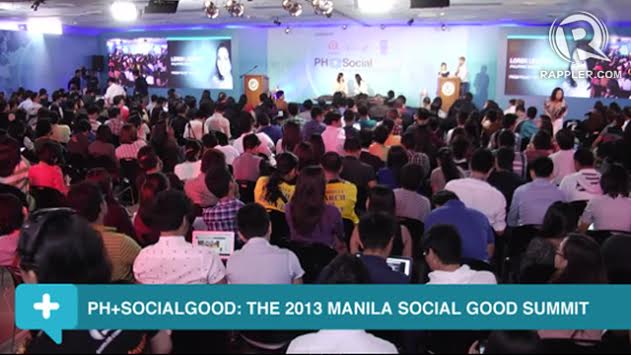SUMMARY
This is AI generated summarization, which may have errors. For context, always refer to the full article.

MANILA, Philippines – PH+Social Good Summit 2014 aims to deepen the conversation of the 2013 summit which began with the question: How can we harness social media and technology to mitigate disaster risks and adapt to climate change?
Since the last summit, the Philippines was brought to its knees by two major disasters: the Central Visayas earthquake in October 2013 and, just a month after, Super Typhoon Yolanda in November 2013.
What have we learned since then? Did the Internet, social media and technology make a difference?
In the 2013 summit, thought leaders, media practitioners, government officials, movers and shakers and hero-netizens shared in a conversation on how technology has changed what we know and revolutionized the action we take based on this new knowledge.
Watch the video highlights of the 2013 summit here:
Google Southeast Asia product manager Andrew McGlinchey talked about innovations at Google that help people prepare and respond to disaster.
The Internet giant’s crisis maps can track casualties and damage to help responders zero in on where help is most needed. Its Person Finder crowdsources names of persons missing in the aftermath of a disaster as well as information to help track them down.
But he emphasized that technology is nothing without the human element. Volunteers who do the “heavy lifting” by filling up forms provide the information that make the platforms effective.
Preparation is also key, he said. It’s only when the information is inputted before the disaster and not during that the technology can be of use.
Making information work for us
But too much information can paralyze. In this age of social media where every Twitter user is a repository and broadcaster of personal knowledge, how do we obtain the kind of information that can save lives?
Patrick Meier, Director of Innovation at the Qatar Foundation Computing Research Institute (QFCRI) said combining data-crunching machines and good ol’ human judgment and initiative is one way around the information barrage.
Examples of this solution in action are the use of hashtags by social media users that make information trackable or the use of apps that enable netizens to verify photos or texts about disasters.
Lastly, the right information has to reach the right people. Three-term Albay governor Joey Salceda explained how his province uses social media to ensure zero casualty and minimize damage.
Albay, which has been recognized internationally for its effective disaster risk reduction and preparation measures, has a social media team that informs citizens of impending calamities, the areas most at risk and the steps to take to ensure their survival.
They use official government information, such as hazard maps of each village or weather announcements by state bureau PAGASA, to let people in on the risks they face and what they can do to keep themselves safe.
Connecting the dots
Philippine Climate Change Commissioner Lucille Sering tied disaster risk reduction to the larger phenomenon of climate change. Global warming makes countries like the Philippines more and more vulnerable to disaster.
United Nations Development Program Country Director Toshihiro Tanaka emphasized the contribution social media and technology can make to longterm solutions to the greatest humanitarian crises.
Senator Loren Legarda discussed how government policies have to keep up with growing risks and vulnerabilities in a country ranked 3rd most vulnerable nation to climate change and disasters in the 2012 World Risk Index.
Rappler CEO and Executive Editor Maria Ressa showed the audience how Rappler uses big data to spot trends and stories that become published content with the aim of informing people and moving them into action.
Project Agos launch
Rappler’s commitment to using social media and technology for good was cemented with the launch of Project Agos during the 2013 summit.
Project Agos is a one-stop online platform that combines disaster mapping, official government information crowdsourcing and volunteerism to prepare and respond to disaster and help in rehabilitation.
This year, Rappler takes PH+Social Good to two cities: Manila and Tacloban in Eastern Visayas, the symbolic center of the impact of the worst typhoon to ever hit land globally.
The summit will take place on September 16-17 in Manila and September 19-20 in Tacloban. – Rappler.com
Add a comment
How does this make you feel?
There are no comments yet. Add your comment to start the conversation.